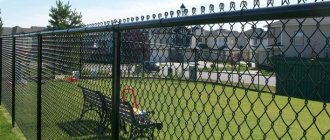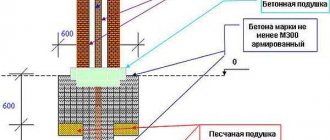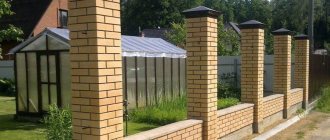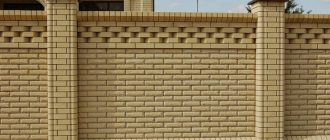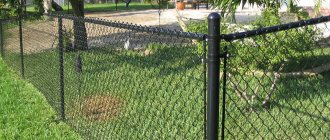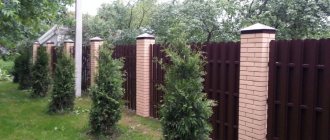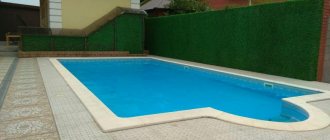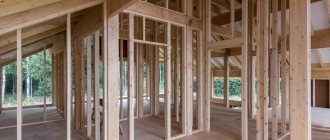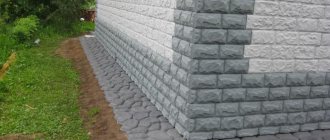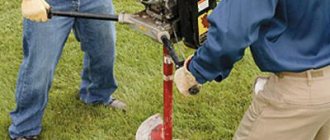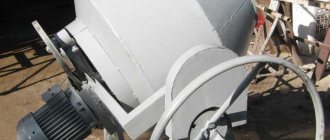Almost always, when the territory of the site of one’s own house is being improved, the owner of the building faces the problem of choosing what material to use to make the fence. It can be made from a variety of materials.
Plastered and painted brick fence posts
Most often used:
- Tree;
- Brick;
- Profiled sheeting;
- chain link fence.
Among all this variety, the first place is always the choice of fence post material.
Basically, pillars are made of the following materials:
- Metal pipes of different sections;
- Pines;
- Reinforced concrete.
Return to contents
Wood
Wooden fence with posts made of profiled timber
Since wood is easy to process and has a fairly low cost, some species began to be used in the manufacture of supports. It is very easy to make wooden poles with your own hands. To do this you need to perform the following operations:
- Remove bark;
- Coat the bottom of the post with a special anti-corrosion compound;
- Drill a hole for the post;
- Insert support.
In order for the post to have a full vertical position, it must be slightly rotated during installation. As a result, such a fence, built from oak parts, can be used for decades, and it will not require additional maintenance. Of course, oak has always been very expensive, so it is replaced with coniferous wood. However, the service life of such pillars is much shorter.
When the pole is made from hardwood, it can last for approximately three years. Of course, wood is not one of the best options for making fence supports.
The cost of wooden poles is quite high, and the service life is very short. You can, of course, treat the material with special antiseptics, which will increase their service life to 15 years.
If, after all, wooden posts were chosen, it is advisable to use copper sulfate for processing. Basically, wooden fences are installed for:
- Palisadnikov;
- Small hedges;
- As temporary fences.
Return to contents
Plastic poles
Plastic supports are available for sale. But only plastic fencing materials are suitable for this. The reliability of such poles is low, so it will not be possible to fix a heavy fence on them. At the same time, plastic supports have a long service life, although they are not designed for heavy loads.
Regardless of the chosen pole material, it is important to install them correctly. The optimal distance should be maintained between the supports, which also depends on the material of the fence.
Fasteners for the construction of frame houses: features of the right choiceTypes of soils and methods of foundation construction
DIY siding installation: similar instructions and a step-by-step master class from experts on the use of siding (130 photos)
Be sure to pour crushed stone into the hole and compact it thoroughly. It is advisable to concrete the support in the upper part, but this is not true for all types of pillars.
Asbestos cement pipes
Such supports have a fundamental difference from wooden poles. They never rot. These pipes have an ideal geometric shape, they do not require special equipment for installation, and they are highly durable. If all technological installation conditions are followed, asbestos-cement pipes will serve for many years.
The disadvantage of this material is the difficulty of attaching the lags. This requires making special brackets and long pins.
The process of installing asbestos cement pipes for the fence
Since such material has increased fragility, it is necessary to be very careful when fixing them in the soil and subsequent concreting of the pillars.
Poles made of this material must be equipped with covers to protect the fence pipe from moisture getting inside the pipe. If the water freezes, it will begin to expand and the pillars will collapse.
Asbestos cement pipes can be classified as economical. This material is highly durable and never rots. Unfortunately, it is difficult to install logs on such pipes; additional work has to be done, which increases labor intensity.
Return to contents
Types of fence posts
There are several types of fence posts: wooden, metal (made from round, rectangular or square pipes, channels, corners), concrete, brick, asbestos-cement.
Wooden supports
Wooden fence posts are suitable for decorative fences (for example, flower beds, lawns), livestock pens, picket fences, wicker fences, picket fences. With proper installation, such a fence will last for years, carefully demarcating the area.
The advantages of this type of poles include: affordable cost; speed and ease of construction; possibility of additional processing and decoration (carving, coating with paints and varnishes, colored impregnations); high fracture strength.
But such supports have many disadvantages. Firstly, they are practically not placed under heavy forged and metal fences due to the danger of sagging under the weight of the latter. Secondly, wood is not suitable for all types of soil. And the third, main drawback is that the material is not durable and is susceptible to environmental influences. Wood without proper periodic treatment (antiseptics, painting, varnishing) quickly rots and loses strength. A fence with wooden posts will last no more than 10 years, unlike its counterpart on metal or concrete posts.
Metal supports
Fence posts made of corrugated board, brick, stone, forged or welded structures are most often made of rolled steel. The main disadvantage of this solution is its price, because high-quality thick-walled metal racks must withstand heavy loads and resist corrosion. It is also important to note that even well-treated metal will eventually require grinding and coating with corrosion-resistant compounds (for example, hammer paint for rust, bitumen or polymer mastic).
But metal supports also have enough advantages:
- strength and durability;
- versatility of use;
- possibility of installation as a support for capital structures;
- aesthetics.
Such posts can be drilled to a fairly large depth for the installation of heavy or solid fencing that can withstand high wind loads. Fences on metal supports can last 30-50 years, provided they are installed correctly and the technology is followed. They have proven themselves well on difficult soils, with strong heaving, and changeable weather conditions.
Concrete supports
They are installed mainly for concrete fences made of finished slabs or other heavy structures (metal, forged sections, monolithic polycarbonate). This type of fencing is reliable, durable, and neat. He is not afraid of temperature changes, strong winds, or precipitation.
But such racks have disadvantages:
- relatively high cost compared to wood;
- requires more time for installation;
- you need the right grade of concrete (M150, 200, 300), capable of withstanding a large number of complete freezing and defrosting cycles.
Fences on concrete foundations can last 30-50 years.
Brick pillars
Brick supports are most often used for brick fences. For greater strength, a metal support is sometimes used, around which a brick shell is built (for example, when strengthening the support for installing metal gates). Suitable for brick, wrought iron, cast or stamped metal fences. In this design they look very beautiful.
They have a lot of advantages:
- high strength;
- long service life (30-50 years);
- decorativeness.
But they also have disadvantages: high cost and construction time. Brick pillars do not require any special treatment or maintenance after installation, if it was done correctly.
Asbestos cement pillars
This is an atypical option for supports for fences, which has recently become popular among summer residents due to its low price. Light wooden fences are attached to such racks; they are not suitable for heavier metal ones due to their fragility. Their advantages include affordable price and quick installation.
The main disadvantages are the fragility of asbestos cement pipes and the need for protective plugs to prevent moisture from entering the pipe. Also, such supports are not aesthetically pleasing.
Steel poles
Today, metal fence supports have become the most popular. They have excellent performance, the main ones being:
- operational;
- strength;
- technological.
Moreover, the cost of such fence supports is quite affordable for every owner. Of course, if water gets inside, they can also crack.
Combined fence made of wood and steel posts
However, this will not cause much inconvenience to the owner of the building when compared with the problems that arise with asbestos-cement pipes. Metal pipes are highly reliable; they can be safely used for decades.
If the supports are made of stainless steel, the service life can reach 50 years. However, not everyone can afford such pipes. Their cost is not affordable for everyone. Today, in almost every building materials market you can purchase metal poles made of:
- From metal pipes;
- From metal profile.
They have a variety of shapes and differ in size and fastening. One important requirement applies to such fence supports: the outer surface must be protected from rust.
For greater stability, these pillars are concreted, having previously welded a support platform.
Fence made of chain-link mesh and metal posts
However, you can do without concreting; it is enough to thoroughly compact the surface with soil. In some cases, metal supports are made from several parts. A pipe is driven into the soil all the way, and another, additional one is welded onto it. As a result, the cost of the fence is reduced, and its appearance becomes original.
Return to contents
Options for installing fence posts
For a clear example, it is necessary to examine several options for installing poles made of different materials. Based on the information provided, you yourself can decide which method is the simplest and most accessible for you.
Metal constructions
In this case, it is best to drive the pillars into the ground. This method is especially effective when there is little rocky soil , into which strong metal pipes can be driven quite easily.
Driving is carried out using a regular sledgehammer . The structure itself is a pipe, the end of which is well welded and weighted up to 20 kg.
Another effective method is concreting, which will be discussed later in the article.
Wooden structures
For wooden pillars, as well as for metal and reinforced concrete ones, the concreting method . This universal method involves preliminary digging a hole for a support, installing a pillar and further filling the space with concrete.
The approximate depth of the hole should be half a meter; in the case of a high post, you can make a deeper hole - 0.8-0.9 m.
Concrete supports
Most owners of private houses prefer to install concrete pillars for their fences. If they contain hydrophobic additives that prevent liquid from entering the concrete body, its service life becomes eternal.
To obtain greater reliability, it is necessary to use reinforced pipes. Such poles can be used for a long time. To maintain the high reliability of concrete pillars, reinforced pipes should not be used during installation.
Return to contents
Without support - nowhere
A fence without reliable supports will not last even a week. And the more solid you choose the material for the fence, the more powerful the posts should be and, accordingly, the better their fixation in the ground.
Metal, wood, brick, reinforced concrete structures and even plastic can be used as supports.
The choice of materials depends on the characteristics of the soil, the strength of the winds on your site and the planned fence fabric
Brick supports
When a fence has brick pillars, it immediately takes on a beautiful appearance and looks very solid. This design requires pouring a strip foundation. The underground part of such a brick pillar should have a width several times greater than the size of the outer part.
Each support is placed in two bricks. The inner part of the support is a metal pipe. To install such a core, you can use a drill. The remaining empty space inside the column is filled with reinforcement in the form:
- Steel bars;
- Wires;
- Construction mesh.
After installing the reinforcement, the entire free distance is concreted.
During laying, the position of the brick is constantly checked, for which a building level is used. The size of the seam is verified by auxiliary rods, the diameter of which is identical to the thickness of the seam. Such rods are laid along the ends of the bricks of the already laid row. After laying the row is completed, the rods are removed from the masonry and placed on the next row.
A fully finished brick support may have an extension to its upper part. To prevent water from getting inside the post, it is covered with a protective cover.
The outer part of the brick pillars is coated with a special special impregnation. As a result, the brick will not collapse, and salt stains will never appear on its surface. The support can be used only 21 days after laying.
Return to contents
The principle of selecting the size of the support
This is a key criterion when purchasing poles. Depends on the relief features of the site and the future load on the fence.
Section (diameter)
Available in the following section types:
- Round. The cheapest option. Available in heights from 2.5 to 4 m. Diameter 57–108 mm. Wall thickness – 3.5 mm. For fencing, pipes with a cross section of 57 and 76 mm are often used.
- Square. Much more convenient to install, but much more expensive. They are produced in lengths from 2.5 to 4 m. Side sizes are 60–100 mm. Wall thickness – 2–4 mm. 60*60 mm is well suited for fence supports.
- Rectangular. The manufactured dimensions are similar to square ones.
The main difference is the shape of the pipe.
The posts to which the gates with wicket will be mounted must have a larger cross-section, since an increased load is placed on them. When using rectangular profile pipes, 100*120 mm is enough, the recommended diameter of round ones is from 109 mm.
For the fence, the cross-section of the corners is from 90 mm, the channel section is from 160 mm. In the section of the structure with the gate, they are connected into a box by welding.
Metal thickness (pipe wall)
In order for the service life of the fence to exceed 20 years, you should select posts with a wall thickness of 3 mm or more.
Height
The total height of the fence is determined by the purpose of the sectional material. If the structure will be installed on the border with a neighboring site, it is better to obtain the approval of neighbors before starting construction in order to avoid conflicts.
Left: post with “ears”, size 40x40 – 60x60 mm. Right: post without “ears”, size 40x40 – 60x60 mm.
The optimal height of the fence is up to 2 m.
To calculate the length of the pillars, you need to add the soil freezing depth and another plus 20 cm to the total height of the fence. In this case, at least ⅓ of the support must be underground.
That is, for a 2 m structure, it is better to take 3 m pillars and bury them one meter into the ground. This is also convenient for saving money, because standard 6 m rolled metal can be cut into 2 even parts.
The number of supports depends on the installation interval. The recommended pitch is 2.5 m.
Choosing pole length
When building a fence, you must always remember that height and density affect the windage of the structure. A fence made of corrugated sheets has the highest windage rate. In strong winds, the supports will have to withstand significant loads. Therefore, for stability, the pillars must be buried in the ground to a third of their length.
The choice of support is also influenced by its height. For corrugated sheeting less than two meters high, it is necessary to have a pole length of more than three meters. It should be buried approximately 1.5 meters into the ground. Moreover, the top of the post may even be lower than the top edge of the fence.
Drawing of a fence made of corrugated board with dimensions of pillars
Return to contents
Methods for installing fence supports
There are 4 main methods of installing fence supports: driving, backfilling, full and partial concreting.
Hammering
Hammering supports without concreting is suitable for relatively low fences made of wood, metal mesh, and plastic. For example, digging wooden posts under a picket fence around a flower bed is not difficult. To do this you will need a small shovel and a hammer. To install supports under a solid palisade 2 meters high, more serious preparation will be required. Stages of driving racks:
- Measuring the parameters of the future fence.
- Preparation of individual elements (pillars, wickets, gates, spans).
- Direct driving into the ground.
When driving to great depths, it is necessary to first dig holes. If you need to secure a structure more than 1.5 meters high, then this method will not work, since at the first strong wind the fence will tilt. Also, simply digging in pillars is not applicable on loose, soft soils or with large heaving.
This method is ideal for small decorative or temporary fences, chain-link fences on rocky and hard soils. Such a fence can be easily dismantled and moved to another location. To install a more durable fence, screwing in the supports is used. Blades are first welded to the pipes, with the help of which the poles can easily be screwed to a great depth into the ground. You will need an assistant for the job, as you will need to constantly align the racks in height.
Zabutovka
Butting fence posts with your own hands is the so-called. “dry concreting”, in which ASG (sand and gravel mixture) is poured into the hole under the pillars. This method can be used on heaving soils.
Backfilling stages:
- Places for supports for the fence are marked. The step should be no more than 2.5 meters.
- By drilling, holes are created for the posts. The diameter is 30-40 cm, so that there is enough space for filling the ASG.
- At the bottom of the hole, lay out 10-15 cm of coarse crushed stone and sand.
- Then the support is installed. It is important to constantly level it vertically using a level.
- The next 15-20 cm layers of ASG are poured, leveling and compacting.
- Each layer is spilled with water.
- 20 cm before the ground surface, the vertical support is finally checked and the hole is filled with M150 concrete.
The installation of corner posts and posts for wickets and gates is done first. Typically, pipes of larger diameter and thickness are prepared for this purpose. Then the remaining supports are installed.
This method will allow, even with severe heaving of the soil, to avoid deformation of the fence and pushing the supports out of the ground. Dry concreting is suitable for metal fences, but if solid or heavy forged elements are expected, it is better to completely concrete the base.
Full concreting
Complete concreting of fence posts makes it possible to install reliable supports for spans made of corrugated sheets, monolithic or corrugated polycarbonate of large thickness, forged gratings, welded structures with a thickness of 14-16 mm and higher. Since full concreting of supports is more often used to create a strip foundation for a fence, the perimeter for the base is initially dug.
Concreting stages:
- Places for supports are allocated and holes are drilled for the fence.
- The larger the diameter of the pipe, the wider the hole should be. On average, it is 20-30 cm.
- A 15-20 cm thick cushion of ASG is placed at the bottom of the pit.
- Install the formwork for the concrete foundation.
- Then the frame for concreting is installed. It is made from longitudinal reinforcement up to 10 mm thick. Bandaged with rods with a diameter of up to 6 mm. Typically, either a strip or columnar strip base is made.
- A metal support is placed in the frame itself in the marked places. It is fixed strictly vertically.
- The prepared solution is poured (usually grade M150-200).
They stand for about a week, after which the formwork is removed and ASG is poured onto the dried concrete. A fence with such supports and a base will stand for decades even on swampy soils with large heaving. But this method is quite expensive in terms of finances, effort, and time. You will also need the help of 1-2 people.
Partial concreting
Partial concreting or a combined method of installing fencing supports is used for point installation of posts, but it is also suitable for fences on strip bases.
Stages of partial concreting:
- Digging a hole to 1/3 of the designed depth.
- Marking the driving depth on a metal post.
- Driving the pipe to the mark.
- Compacting a bulk cushion made of ASG with a thickness of 10-15 cm.
- Installation of formwork and frame is similar to the full concreting method.
- Pouring concrete solution.
- Removing the formwork after a week and filling the hole with soil.
Installing metal poles using this method is much cheaper due to savings on concrete and reinforcement. The supports are reliable and durable, but dismantling them without completely destroying the structure is impossible. A fence on such a support is installed “for centuries.”
If you want to save time, effort and get excellent results, it is better to turn to professionals. The Zaborkin company is engaged in the production, sale and installation of various fences, gates, turnkey gates in Moscow and the Moscow region.
Correct installation of pillars
It doesn't matter what the pole is made of; To dig a hole for installing posts, it is best to use a drilling tool. The size of the hole should be 15 cm larger than the diameter of the post. The depth of the hole should exceed half a meter.
The bottom of the pit is covered with crushed stone; you can also cover it with stones. After this, the pillar is mounted, the free space is filled with stones, taking into account the space for pouring concrete. When pouring concrete mortar, the pillar is held in place.
When pouring concrete, you can slightly shake the pillar to completely fill the free space. The column must be level, since it will be impossible to correct even a slight deviation after the concrete has hardened.
